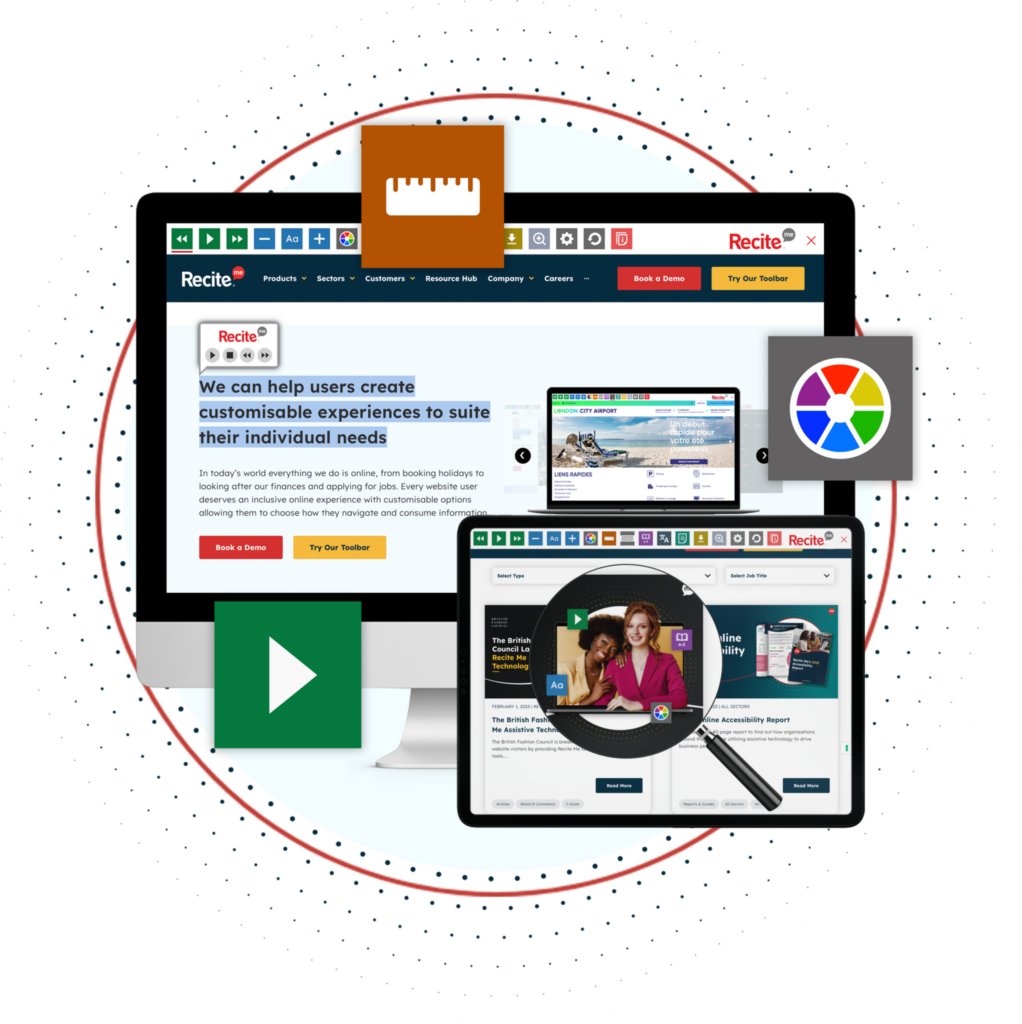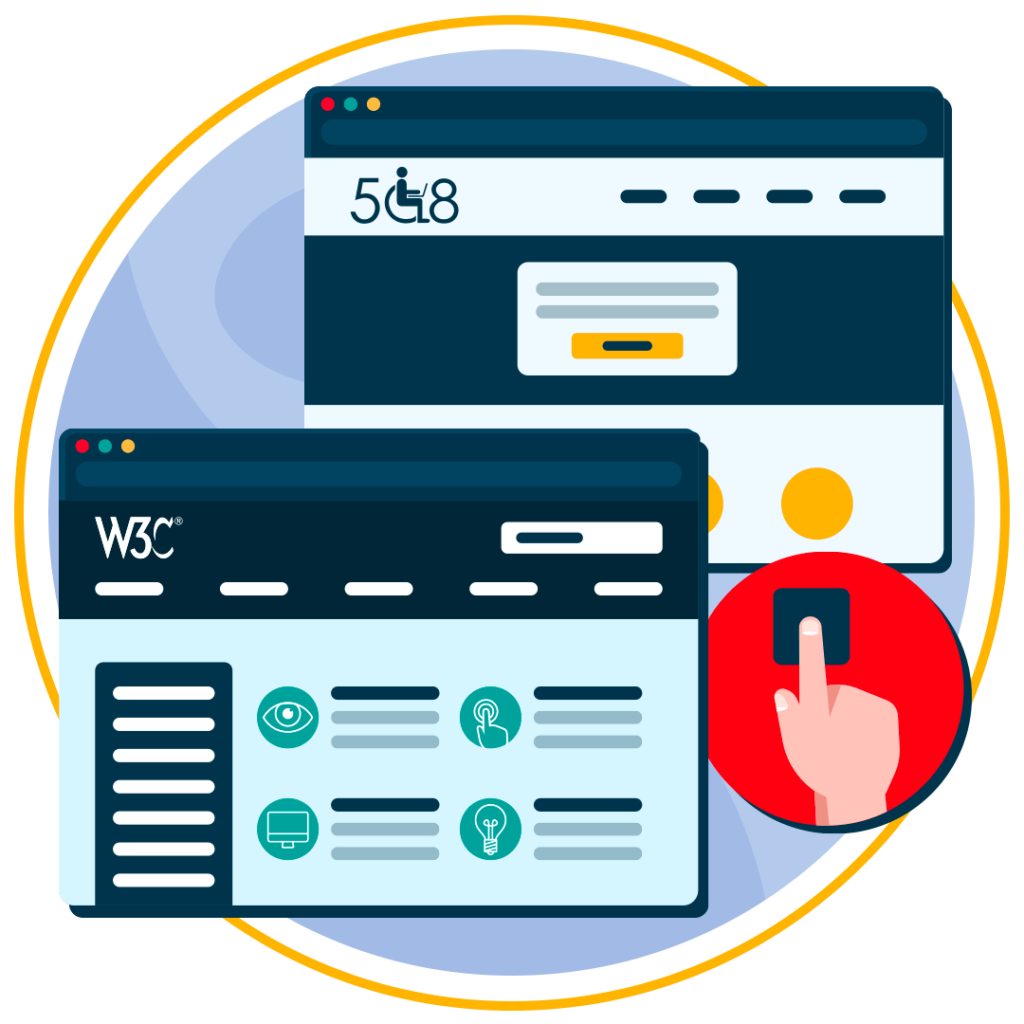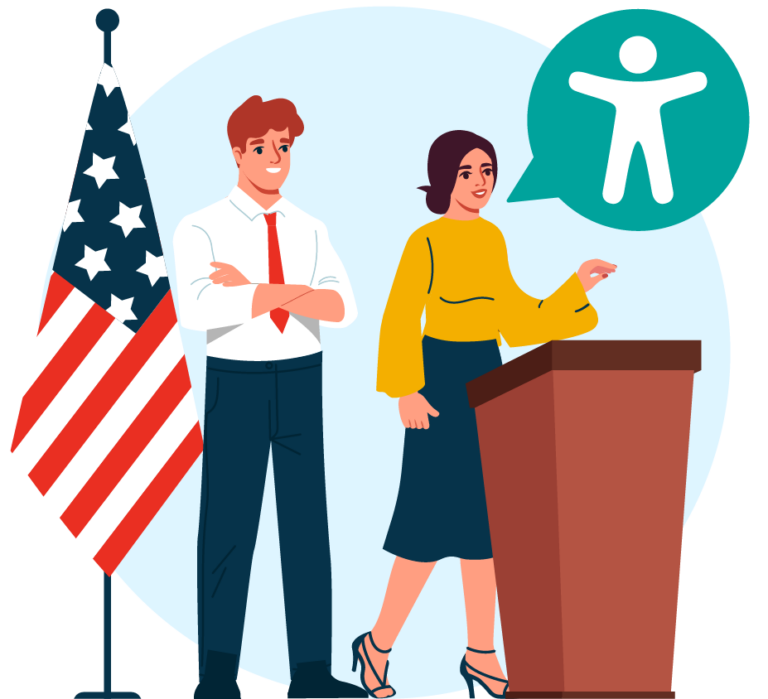Ensuring that everyone has equal access to online information and services is crucial. However, keeping up-to-date with digital accessibility requirements can be challenging and confusing for many organizations, especially those without digital accessibility experts on staff.
The three frameworks that cause the most confusion are the Americans with Disabilities Act (ADA), Section 508 of the Rehabilitation Act, and the Web Content Accessibility Guidelines (WCAG).
You can access information about the differences between WCAG and the ADA or Section 508 Vs the ADA in our previous blogs, but in this article, we’ll be focussing on Section 508 vs. WCAG. We’ll begin with a quick overview before moving on to provide more comprehensive definitions and breakdowns to help you fully understand the differences.
WCAG Vs. Section 508: A Comparative Summary
Here’s a quick reference overview of the primary differences between WCAG and Section 508. We’ll explore each aspect in more detail throughout the following sections.
Aspect | WCAG | Section 508 |
| Authority | W3C | US Congress |
| Legal Framework | International Guidelines | US Federal Law |
| Primary focus | Digital Accessibility | Accessibility in Federal Agencies |
| Applicability | Global | USA |
| Enforcement | Self-regulation | Department of Justice (DOJ) and Federal Agencies |
| Compliance levels | A, AA, AAA | Standards specified by the US Access Board |
What is WCAG?
The Web Content Accessibility Guidelines (WCAG) are a set of internationally recognized web accessibility standards developed by the World Wide Web Consortium (W3C). W3C is an international organization comprising several member entities and industry professionals, including Tim Berners-Lee, the computer scientist widely credited with inventing the World Wide Web.
WCAG provides a comprehensive framework for making web content accessible to individuals with various disabilities, including visual, auditory, motor, cognitive, and neurological impairments. Since its initial release in 1999, the guidelines have undergone several revisions. The most recent version is WCAG 2.2. However, WCAG 3.0 is expected to be published in the near future, promising further advancements in accessibility standards.
What is the Section 508?
Section 508 of The Rehabilitation Act of 1973 was enacted in 1998. An update to the original Rehabilitation Act, the inclusion of Section 508 marked a recognition by the government that more needed to be done to protect the rights of people with disabilities in an increasingly digital world.
The digital accessibility standards outlined in Section 508 have been developed by the US Access Board to ensure that all online content and digital resources owned and published by federal agencies are accessible to everyone, including individuals with disabilities.

Free WCAG Compliance Check of your Website
Finding accessibility issues is now easier than ever. Recite Me offers a free automated scan of your website’s homepage to highlight non-compliance. You’ll get recommendations on how to fix them, helping to improve your accessibility score.
What’s the Difference Between Section 508 and WCAC?
The key differences between WCAG and Section 508 lie in legal status, scope, applicability, compliance measures, and enforcement.
WCAG Vs. Section 508: Legal Status
WCAG is a set of international guidelines that many countries adopt as the foundation for digital accessibility legislation. However, while WCAG significantly influences global accessibility standards and is considered the gold standard from a compliance perspective, following the guidelines is not a legal requirement. In contrast, Section 508 is a federal law in the United States, mandating compliance for all federal agencies and their contractors.
WCAG Vs Section 508: Scope
Section 508 and the Web Content Accessibility Guidelines both focus solely on digital accessibility, and Section 508 is the only piece of national legislation dedicated to electronic and information technology. However, from a compliance perspective, it’s worth noting that the following states have enacted additional stand-alone legislation that supersede Section 508 requirements:
WCAG Vs Section 508: Applicability
WCAG applies globally and influences digital accessibility best practices across a wide range of private and public sector organizations. Conversely, Section 508 applies specifically to US federal agencies and their contractors, ensuring that all electronic resources and information technology used by government employees and members of the public are accessible.
WCAG Vs Section 508: Compliance Measures
The Web Content Accessibility Guidelines are separated into four cornerstone ‘POUR’ principles to ensure online content is suitably:
- Perceivable – Presented in ways that various sensory modalities can perceive.
- Operable – Navigable by all users and assistive technologies.
- Understandable – Organized logically using clear language and navigation structures to facilitate comprehension.
- Robust – Usable by a variety of user agents, including screen readers.
Success criteria from across each principle are broken down into varying levels of conformance as follows:
- Level A (Basic) – 30 fundamental accessibility criteria without which a website is considered inaccessible.
- Level AA (Industry Standard) – An additional 30 criteria that should be covered to meet an industry-accepted standard of accessibility.
- Level AAA (Advanced) – A total of 78 criteria representing the highest possible level of accessibility.
Now, let’s take a look at compliance with specific regard to Section 508.
The US Access Board has developed its criteria with two primary goals in mind – ensuring equitable access to digital resources for both federal sector employees and members of the public:
- Equal Access for Federal Employees – Digital infrastructure must facilitate equal access to online resources for employees with disabilities.
- Comparable Access for the Public – Members of the public seeking federal information or services must have equitable access to digital resources.
The US Access Board criteria are based on compliance with WCAG 2.0 Level AA. However, compliance with the most up-to-date version (WCAG 2.2) is highly recommended to avoid unnecessary legal risk.
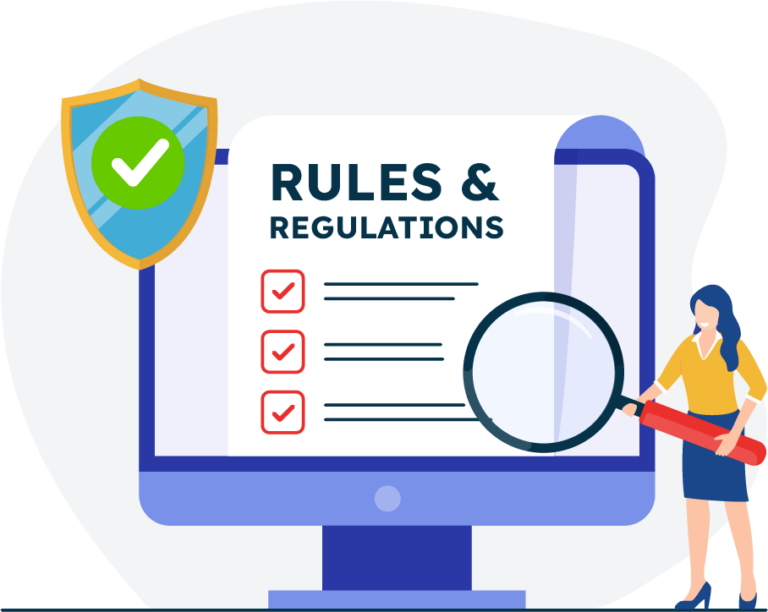
WCAG Vs Section 508: Enforcement
WCAG compliance is generally self-regulated, with organizations encouraged to adhere to the guidelines wherever possible to avoid legal risks and ensure inclusivity. In contrast, Section 508 compliance is enforced by the Department of Justice (DOJ) and various other federal agencies. Therefore, non-compliance can result in Section 508 lawsuits with significant legal and financial consequences:
- Fines of up to $55,000 for the first violation and up to $110,000 for subsequent violations.
- The loss of federal grants and funding.
- Costly legal fees and bills for mandatory accessibility improvements.
- Increased regulatory scrutiny and monitoring.
Common Misconceptions about WCAG and Section 508 Compliance
Understanding the differences between WCAG and Section 508 is essential. However, it’s also important to address some common misconceptions that could inadvertently lead to non-compliance. Here’s a list of common myths that could potentially land you in trouble.
Myth 1: Section 508 Only Applies to Government Bodies
This is incorrect. While the primary focus is on federal agencies like state offices, branches, and departments, Section 508 also applies to third-party contractors and vendors providing products and services to federal organizations, and to any entity receiving grants or funding from government offices. This may include, but is not limited to:
- Technology, software, and telecommunications providers.
- Engineering and construction firms.
- Charities, conservation groups, research institutions, and community development organizations.
- Publicly funded healthcare, finance, education, and transport organizations.
Myth 2: Only Websites Need to Be Section 508 Compliant
Nope! All types of electronic and information technology produced, procured, or maintained by the federal government must be accessible. In addition to websites, this includes, but is not limited to:
- Computer hardware
- Computer software
- Electronic documents
- Phone systems
- Video and multimedia content
- Emails and newsletters
- Training resources
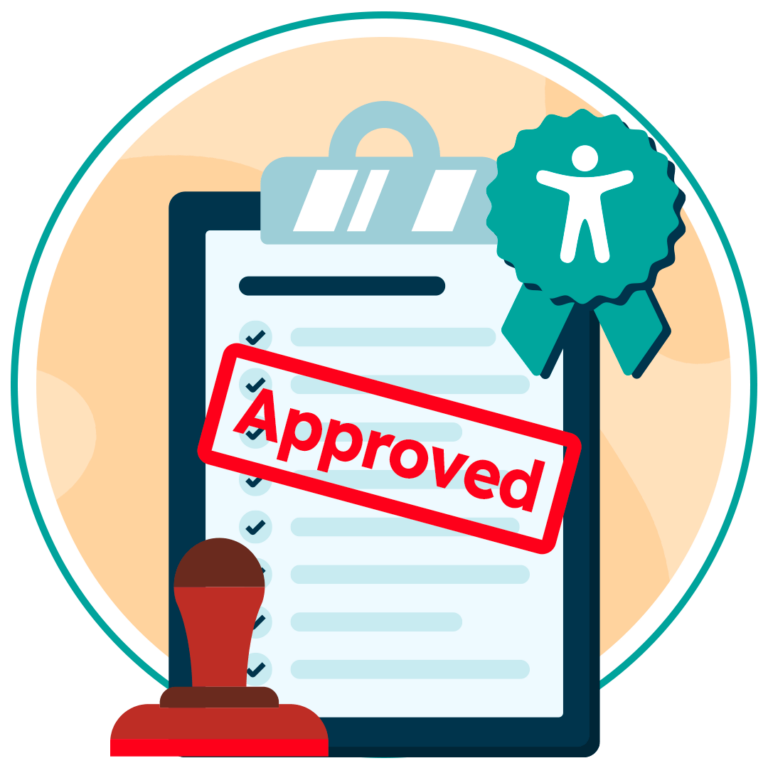
Myth 3: ADA and Section 508 Compliance are the Same Thing
Not so. While it’s true that some practical requirements of each federal law overlap, the ADA and Section 508 cover different criteria. So, just because you’re ADA compliant, that doesn’t mean your resources are automatically section 508 compliant, and visa-versa.
Myth 4: Becoming Section 508 Compliant is a One-Time-And-Done Task
This couldn’t be further from the truth. In the digital realm, the only constant is change, meaning ongoing vigilance, regular reassessment, and continuous updates are required to maintain ongoing accessibility for all.
Stay ahead of the game when it comes to Digital Accessibility laws and compliance in the United States. Learn about all the different federal and state-level regulations, see real examples of web accessibility lawsuits in different regions and discover a 7-step action plan for building accessible websites.
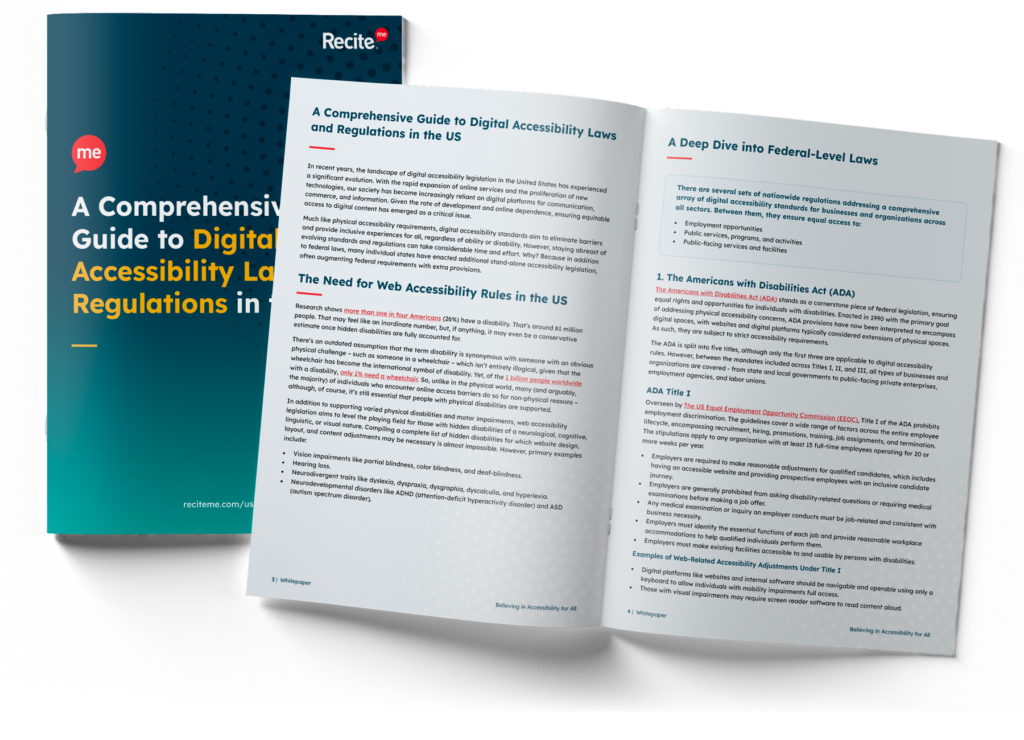
How to Comply with WCAG and Section 508 Standards
Why wait until you run into a problem to make digital accessibility improvements? Proactive measures are the best way to avoid legal risk and ensure accessibility for all. To that end, Recite Me has developed a suite of on-demand accessibility tools to enhance understanding and streamline the process of becoming legally compliant.
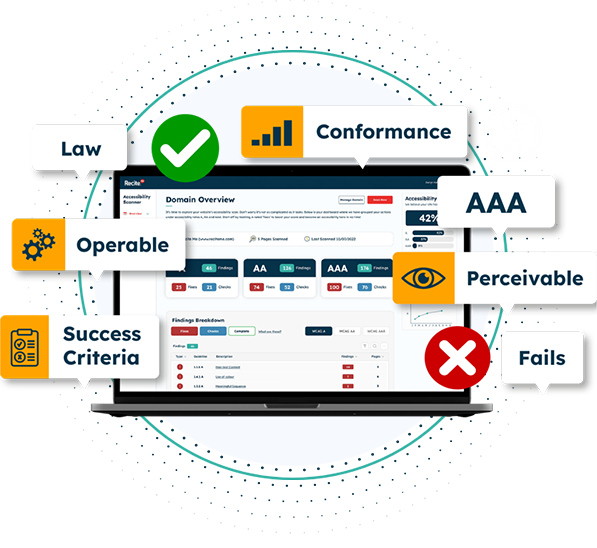
Accessibility Checker
Our Accessibility Checker can help address inaccessibility at its root cause. As the tool performs a complete scan of your website in line with the latest WCAG standards and guidelines. By following a simple four step process to help improve your websites accessibility:
- Step 1: Scan Your Domains – Choose between scanning single or multiple pages.
- Step 2: Identify Accessibility Issues – Identify the locations of accessibility issues on your website.
- Step 3: Fix Accessibility Errors – Boost your accessibility score by prioritizing fixes in line with WCAG Levels A, AA, and AAA.
- Step 4: Track Your Progress – Create and share custom reports with your team and roadmap the next issues in your fix queue.
Accessibility Toolbar
The Recite Me Accessibility Toolbar is a simple software that installs on to your website to help make it more inclusive. This won’t directly make your website WCAG or Section 508 compliant, but it does allows users to customize your website in a way that works best for them. Some of the main features include:
- Personalizing font size, type, and color options.
- Choosing the exact color contrast between the text and background.
- Utilizing the mask screen tool to help with focus.
- Using the ruler tool to make reading easier.
- Downloading content as an audio file as an alternative to reading.
- Converting page content into over 100 on-screen languages.
- Having the page read aloud in a choice of 65 languages.
- Customising PDF documents or having them read aloud/ translated.
- Zooming in on any part of a webpage.
- Using the built-in spell-checker and a fully integrated dictionary and thesaurus.
